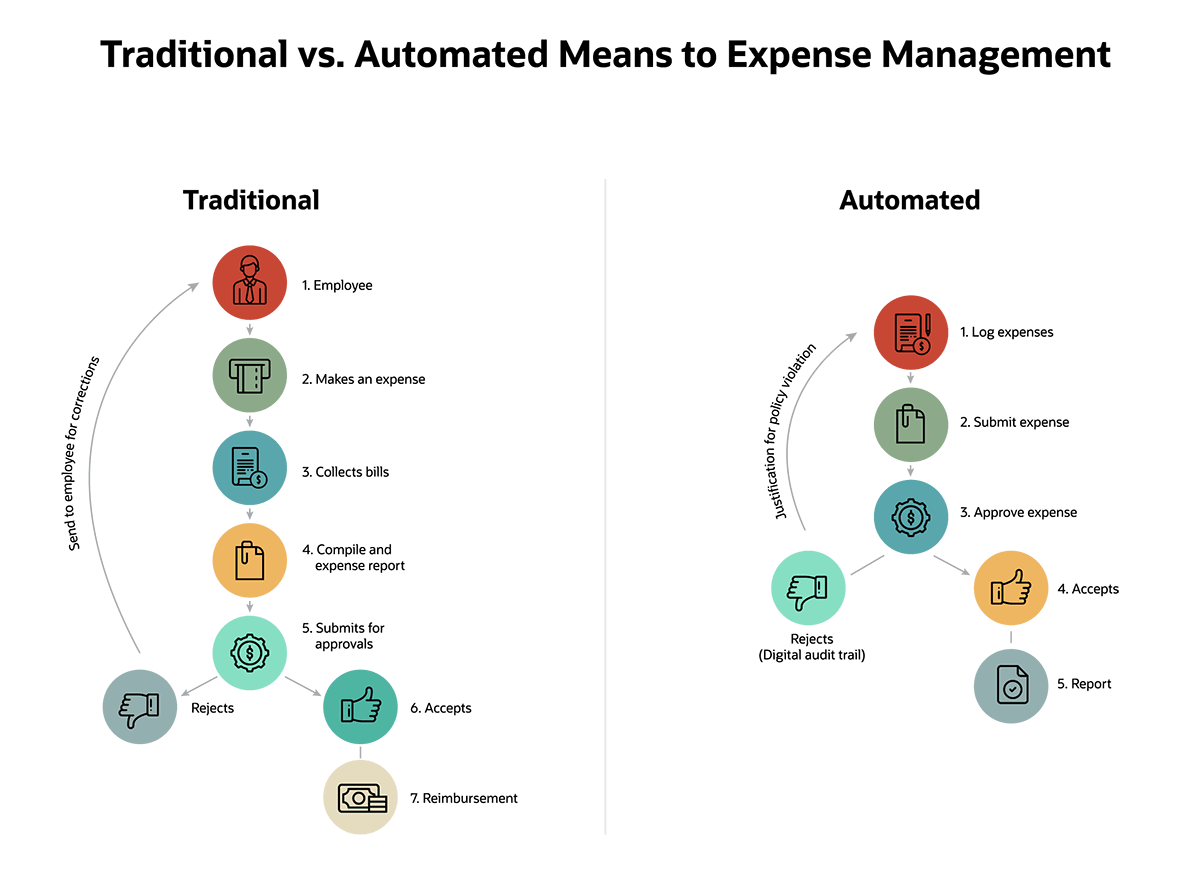Managing business expenses is a key concern for all companies, and one that’s difficult to orchestrate with manual processes, paper receipts and handwritten notes. By using software to track and monitor employee spending, companies can speed up the expense management process, reduce errors and distribute reimbursements faster.
What Is Expense Management?
Expense management not only tracks employee spending but also determines how the organisation will reimburse the costs incurred. It also applies the procedures and policies used to control this type of spending. For example, if employees are given daily allowances for meals when travelling, then the expense management process accounts for those limits when generating reimbursements for workers.
Why Is Expense Management Important?
All companies must be able to pay their bills on time in order to stay in business, and employee expenses are one of those bills. For any company with employees who conduct business outside of the office, expense management will always be vital. Even something as simple as a client lunch paid for by an outside sales manager needs to be documented, approved and reimbursed.
With effective expense management processes in place, companies can issue those reimbursements quickly and accurately. Employees don’t like waiting months after they cover an expense to get reimbursed.
Types of Expense Management
Companies have different ways of managing expenses, including:
- Paper tracking. This is the traditional—and outdated—way to manage expenses, with employees collecting paper receipts and submitting them to the accounting department for approval on a monthly or quarterly basis.
- Spreadsheets. This is a popular choice among companies trying to reduce their reliance on paper that have yet to move over to a dedicated, automated expense management system.
- Expense management software. This approach simplifies the expense management process. The software alerts managers to expense reports needing review, letting them accept or reject the claim. Approved expenses are then automatically routed to accounting for reimbursement.
Expense Management Process
Expense management is a multi-step process that includes capturing and submitting expenses, which can involve: submitting reimbursement claims, approving or denying those claims, scheduling the claims for payment, and, finally, reimbursing the employee.
With the right process in place, companies can monitor their spending, ensure employees aren’t abusing the system, and take quick corrective action if they are (e.g., letting individual employees know that they’re spending more than they should be in specific areas). If, for example, a salesperson has been flying first class without prior approval to do so, a quick check of his or her receipts will reveal the violation.
It can be difficult to find these issues with manual systems, particularly for a company with a growing team of field workers. Missing information, approval of spending without a thorough review and slow approvals are all common issues. This not only wastes employees’ time but also leaves employees wondering where their expense checks are (often as they’re already racking up new expenses for the next closing period).

As with all manual business processes, managing expenses manually can be inefficient, time-consuming and error-prone. However, a recent survey found a large percentage of companies are still doing it—and not reaping the benefits of automated expense management:
- 30% of companies still manage expense reporting manually.
- 27% of companies don’t plan expand or upgrade their travel and expense management solution
- 35% don’t prioritise improving the user experience for travel and expense reporting
The benefits of automating this aspect of a company’s operations are well-documented. Of the companies that have invested in or plan to invest in technology to facilitate expense management, 69% cite improving the end-to-end experience of travel and expense is a primary reason for the move, while 68% are looking to improve their ability to derive actionable insights from running analytics on travel and expenses.
Other key motivators include the need for real-time insights into spending and the need to have the entire company’s spend management activity on a single platform rather than spread across various spreadsheets and papers.
Expense Management Policy
One of the best ways to control employee spending is to implement an expense management policy for everyone to follow. A policy can justify why an expense is rejected or questioned and help make the final decision on whether to reimburse the costs.
All expense management policies should include:
- A complete list of which expenses the company will pay for.
- A complete list of expenses the company will not pay for.
- Clear and concise language (so there are no questions about what is/isn’t admissible).
It’s crucial that organisations update their expense management policy regularly. As your company grows and expands into new lines of business, it will need to adjust this policy to accommodate those changes.
Don’t forget to incorporate best practices like requiring pre-approvals for certain expenses, clearly defining the steps in the approval process and other elements that can help minimise potential problems when someone flags expenses.
What Is an Expense Management System?
An expense management system is software that simplifies the employee expense reimbursement process by automating much of it. The software reduces the need for paper, lowers the amount of time spent handling expenses and minimises errors.
#1 Cloud
Accounting Software
What Does an Expense Management System Do?
This system automates the recording, tracking, approval and payment of reimbursable expenses incurred by employees. Expense management software aligns with the company’s expense management policy to ensure the business doesn’t overspend on approved (or unapproved) expenses.
An expense management system also provides analytical tools that help the organisation make better decisions about future spending and inform any necessary adjustments to its policy. Finally, the system helps organisations maintain compliance and accountability by accurately reporting on all expenses.
Integrating expense management software with an ERP or accounting system provides additional benefits. For one, it eliminates the need for accounting staff to upload or manually enter expense report data, saving time and reducing the risk of errors. Once approved, expenses are then automatically scheduled for payment, resulting in faster employee reimbursement.
Combining expense report data with ERP data also leads to a richer analysis across all spend categories, as well as by region, brand or other business segment. For instance, integration allows services companies to more easily tie expenses to individual projects, eliminating questions about how expenses should be allocated or which customer they should be billed to.
Expense Management Software Features & Capabilities
Here are some of the key features and capabilities of expense management software:
- Track all employee receipts
- Allow employees to use their smartphones to capture receipts
- Put the receipts on a centralised dashboard
- Document spending limits and company policies
- Allow companies to change these limits and policies as necessary
- Integrate with corporate credit cards (if applicable)
- Route the receipts to the appropriate approvers
- Manage those approvals or flag those that need more attention
- Check for policy violations
- Schedule reimbursement checks for payment
Why Use an Expense Management System?
Manual expense report management is both expensive and time-consuming. According to the Global Business Travel Association, it takes an average:
- 20 minutes to complete one expense report
- 18 minutes to correct an expense report
- $58 to process one expense report
- $52 to correct one expense report
Companies that automate the expense management process can dramatically cut down on the amount of time and money spent on this important task. At the same time, they gain better insights into the spending habits of individual employees, making it easier to pinpoint unusually high expenses so they can be addressed.
Expense Management Software Advantages
Expense management software helps companies automate a time-consuming process, gain better control over individual employee expenditures (not general company expenses) and reduce errors. The software also provides reliable tracking (e.g., instant notifications when an associate enters receipts using his or her smartphone), faster reporting and better compliance with company policies.
Using custom workflows, the software also simplifies the expense approval process by automatically routing those tasks to the right people. Finally, these solutions incorporate analytics that can quickly detect potential problems and improve decision-making.
Choosing an Expense Management System
There are many different expense management systems available today, and not all of them are created equal. As with any technology purchase, you’ll want to make sure the solution offers the right level of functionality, can accommodate your company’s specific needs and comes with a high level of post-sale support.
Common functionalities to look for and compare among vendors include:
- Document management to create audit trails.
- Easy, customisable approval processes.
- Customisable expense policies, with real-time checks for employee compliance.
- Mobile accessibility on many kinds of devices.
- Analytics and reporting.
- Integration with other software systems.
Once you’ve identified your company’s needs, explore your options and request demonstrations. Talk to other companies (preferably within your industry) that are successfully using an expense management system, and be sure to evaluate multiple options before making your final decision.









